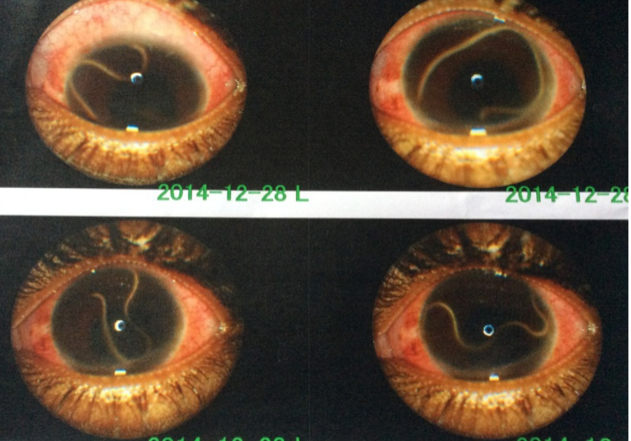What’s the most likely diagnosis for this adult male?
A 32-year-old male who recently emigrated from West Africa presents with eye pain and irritation. The pertinent physical exam is shown below. Which of the following is the most likely diagnosis?
Question Answer Choices
- Ascariasis
- Loiasis
- Onchocerciasis
- Paragonimiasis
- Trichuriasis
Question Explanation
Correct answer: B. Loiasis
Loiasis, also known as “eye worm,” refers to a disease caused by a filarial worm, Loa loa, found in the western and central African rainforests. It is transmitted by the bite of the female Chrysops fly, which deposits larvae into the wound when she takes a blood meal.
Adult worms live in the subcutaneous tissues and may persist for up to 18 years after exposure. High-grade eosinophilia is often present.
Worms may cause painful “Calabar swelling” on the extremities or face. As in the case patient, the worms can migrate to the eye and be seen transiting the conjunctiva, causing injection, irritation, edema and pain. Subconjunctival worms can be removed with analgesia and fine tweezers, but treatment of the systemic worm burden requires antiparasitic therapy.
Infection with Loa loa may coexist with onchocerciasis, and co-infection is important to identify since it affects treatment. Loiasis is treated with diethylcarbamazine, which is contraindicated in patients with coexisting onchocerciasis unless the onchocerciasis is treated first. If diethylcarbamazine is given to patients with untreated onchocerciasis, a severe inflammatory response may occur, leading to blindness.
Incorrect answer choices:
Ascariasis (Choice A) is a roundworm infestation of the intestines. Worms do not transit across the eye but may migrate to the lungs, causing dry cough or eosinophilic pulmonary infiltrates. Large burdens of intestinal worms may lead to anemia, malnutrition or bowel obstruction.
Onchocerciasis (Choice C) is a parasitic disease with a range that overlaps with loiasis, and may also involve the eye. However, worms are not seen traveling across the conjunctiva as in the case patient. In onchocerciasis, worms may invade the eye and then cause inflammation leading to blindness when they die.
Paragonimiasis (Choice D) is a trematode infection that predominantly affects the lungs. It is found in China, Japan, the Philippines, Thailand, Taiwan, Vietnam and South Korea. Larvae may be ingested when contaminated raw or pickled crustaceans are eaten.
Six to 12 weeks after ingestion, the larvae migrate from the intestines to the lungs and cause a clinical syndrome of pleuritic chest pain, pleural effusions, hemoptysis, fever and night sweats. It is often misdiagnosed as tuberculosis. Less commonly, flukes may disperse to other locations including the brain, eye or GU tract, but worms will not be visualized crossing the conjunctiva.
Trichuriasis (Choice E) is a whipworm infestation of the GI tract. Symptoms are minimal when there is a light worm burden. Heavier worm loads cause abdominal symptoms, dysentery and rectal prolapse. Ocular involvement does not occur.
References
D’Andrea, Shawn M and De Wulf, Annelies. Chapter 162: Global Travelers. In Tintinalli JE, Ma O, Stapczynski J, Yealy DM, Meckler GD, Cline DM, Thomas, Stephen H, eds. Tintinalli’s Emergency Medicine: A Comprehensive Study Guide, 9e. New York, NY: McGraw-Hill; 2020.
https://www.cdc.gov/parasites/paragonimus/epi.html









